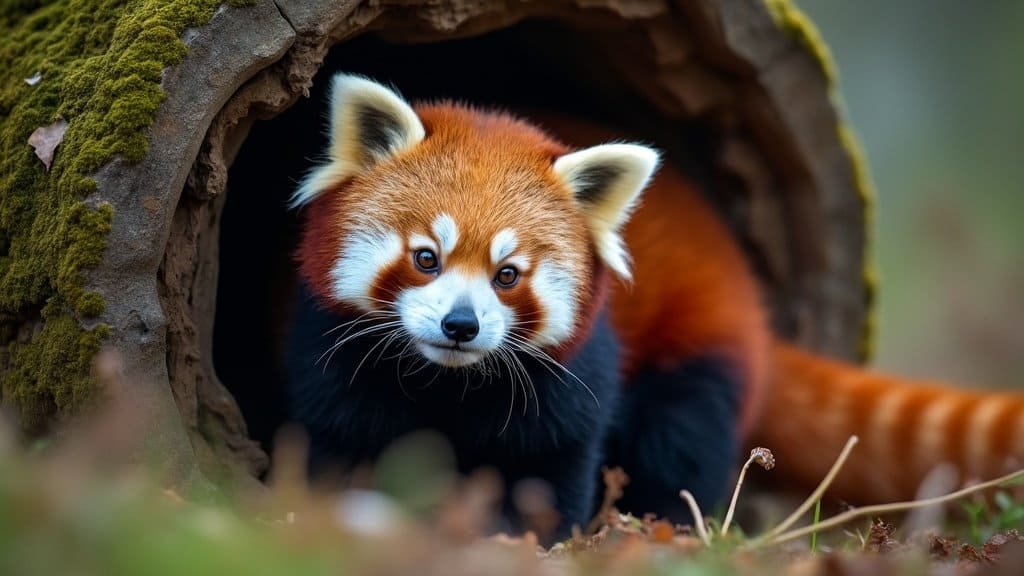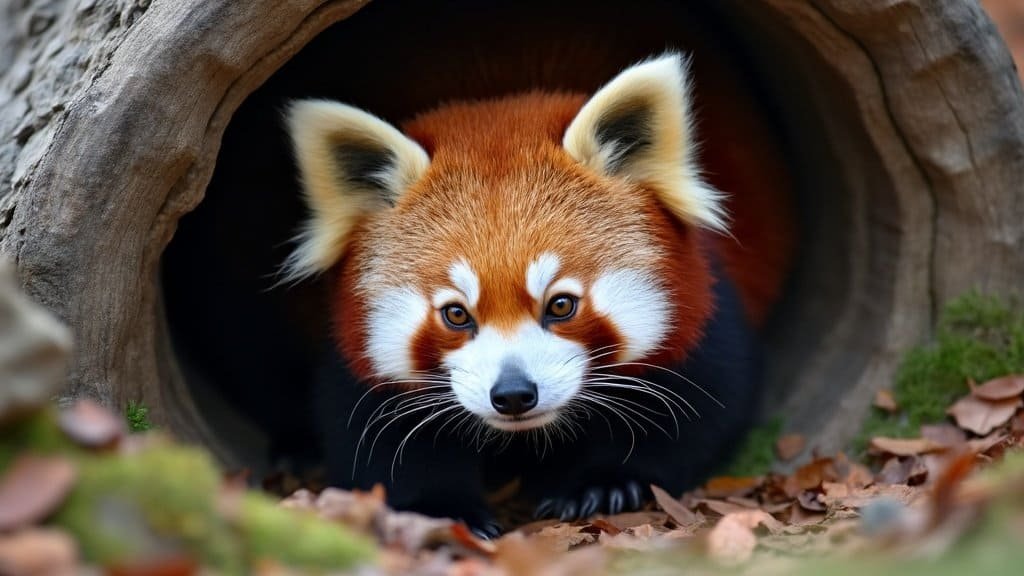During pregnancy, female red pandas undergo several behavioral changes to prepare for birth and ensure the survival of their cubs. As solitary animals, they instinctively seek out secure nesting sites in tree hollows, rock crevices, or dense vegetation, carefully lining these spaces with soft materials such as leaves, grass, and moss. In the final weeks before birth, their activity levels decrease as they conserve energy for labor and nursing. Their feeding habits also change, with an increased focus on high-nutrient bamboo shoots early in pregnancy, followed by a gradual reduction in food intake closer to birth
Pregnant red pandas also show a decline in scent-marking behavior, a shift that helps them avoid drawing attention from potential predators or rival pandas. Additionally, they engage in frequent grooming, a behavior that serves both hygienic and stress-relief functions. Understanding these behavioral adaptations is crucial for conservation efforts, particularly in captive breeding programs where proper environmental conditions must be maintained
This article explores the key behavioral changes in female red pandas during pregnancy, from nesting behaviors and activity levels to social interactions and physical transformations
Behavioral Adaptations in Pregnant Red Pandas

Pregnancy in red pandas is accompanied by a series of behavioral adaptations designed to ensure the safety and well-being of both the mother and her cubs. As the gestation period progresses, female red pandas gradually shift their daily routines, prioritizing energy conservation, nesting, and preparing for birth. These behavioral changes become most noticeable in the final weeks before parturition, when the female’s focus turns entirely to creating a secure environment for her offspring
How Female Red Pandas Prepare Their Nests for Birth
One of the most significant behavioral changes observed in pregnant red pandas is their instinct to build a secure nest. Nesting typically begins several weeks before birth, with the female actively searching for an appropriate den site. In the wild, red pandas prefer natural shelters such as tree hollows, rock crevices, or dense bamboo thickets, locations that provide both insulation and protection from predators
Once a site is selected, the female gathers a variety of materials—including leaves, moss, twigs, and grass—to line the nest, creating a soft and insulated space for her cubs. Nest preparation intensifies as the birth date approaches, with females frequently rearranging materials to ensure maximum comfort and warmth
In captivity, pregnant red pandas display similar behaviors, often utilizing nesting boxes provided by zookeepers. While the materials may be artificially supplied, the instinct to arrange and modify the nest remains unchanged
Changes in Activity Levels During Pregnancy
As pregnancy progresses, female red pandas become increasingly lethargic. During the first few weeks of gestation, their daily routines remain relatively unchanged, but by the final month, their activity levels decline significantly. This reduction in movement is a strategic energy-conservation mechanism, allowing the female to allocate more resources toward fetal development and preparing for the energy-intensive demands of lactation
Researchers studying red pandas in conservation settings have observed that pregnant females spend longer periods resting, often choosing to remain in or near their nesting sites. Unlike non-pregnant individuals, who may explore larger territories in search of food, expectant mothers minimize unnecessary movement, instead prioritizing nesting and feeding in close proximity to their dens. This shift in behavior ensures that they are well-rested and prepared for the physically demanding process of giving birth and caring for their newborn cubs
Feeding Habits and Nutritional Needs of Expecting Red Pandas
The dietary habits of pregnant red pandas undergo noticeable changes, particularly in terms of food quantity and selection. In the early stages of pregnancy, females exhibit an increased appetite, consuming larger quantities of bamboo to build up fat reserves. Bamboo, which forms the majority of their diet, provides essential nutrients needed to sustain both the mother and the developing cubs
However, as birth approaches, food intake gradually decreases. This decline is believed to be linked to hormonal shifts and the female’s focus on nesting behaviors, which take priority over foraging. In some cases, pregnant red pandas become more selective in their food choices, favoring younger bamboo shoots that are easier to digest. In captivity, zookeepers monitor these dietary changes closely, adjusting feeding schedules and providing supplemental nutrition when necessary to support a healthy pregnancy
The balance between increased food intake early in gestation and reduced consumption closer to birth highlights the complex physiological adaptations that allow red pandas to successfully carry and deliver their young. For more detailed insights into how pregnancy affects red panda behavior, you can explore this scientific study on reproductive adaptations
Social and Environmental Factors Influencing Pregnancy

Pregnancy in red pandas is not only a physiological process but also a period marked by behavioral adjustments in response to their surroundings. Expectant mothers become more cautious, altering their scent-marking routines and reactions to external threats
Their solitary nature is further reinforced during this time, as they instinctively isolate themselves to minimize stress and potential dangers. These social and environmental adaptations play a crucial role in ensuring a successful pregnancy and the survival of newborn cubs
How Scent-Marking Behavior Changes in Pregnant Red Pandas
Scent-marking is an essential communication tool for red pandas, allowing them to establish territory, signal reproductive status, and identify other individuals. However, during pregnancy, females significantly reduce their scent-marking behaviors. This decline is believed to be an evolutionary adaptation aimed at avoiding unwanted attention from other red pandas or predators
Since non-pregnant females use scent-marking extensively during estrus to attract mates, the sudden reduction in these signals indicates a shift in priorities. Pregnant red pandas become less concerned with territorial reinforcement and more focused on nest preparation. Studies conducted on captive populations have shown that pregnant females may continue to scent-mark occasionally but at a much lower frequency compared to their non-pregnant counterparts
In the wild, this behavioral shift likely reduces the risk of encounters with other red pandas, decreasing the likelihood of territorial disputes or disruptions near the nesting site
Responses to Threats and Disturbances Before Birth
As the birth date approaches, pregnant red pandas exhibit heightened vigilance and an increased sensitivity to disturbances in their environment. This change in behavior ensures that they remain alert to potential dangers that could threaten their cubs. When faced with an unfamiliar presence, a pregnant red panda is more likely to retreat deeper into her nest rather than confront the threat directly
In some cases, if disturbances are frequent or prolonged, she may abandon the original nest and relocate to a more secure location. This defensive strategy is particularly important in fragmented habitats where human activity or predator presence may be higher. Conservation studies in Nepal and Bhutan have observed that pregnant red pandas in areas with increased human activity spend more time hidden in dense vegetation, suggesting that environmental stressors influence their nesting choices
In captivity, pregnant females may display similar behaviors, preferring enclosed spaces or avoiding areas with high foot traffic. Understanding these stress-related responses helps conservationists develop strategies to minimize disturbances in both wild and managed populations
Isolation and Social Behavior in Pregnant Red Pandas
Red pandas are naturally solitary animals, and this characteristic becomes even more pronounced during pregnancy. Expectant females actively avoid interactions with other red pandas, including potential mates, previous offspring, or unfamiliar individuals. This isolation behavior ensures that the mother remains undisturbed as she prepares for birth. Unlike some species that rely on social bonds for protection or cooperative parenting, red pandas are entirely self-sufficient, with females taking on full responsibility for nesting and cub-rearing
In captive settings, pregnant females housed in shared enclosures may display avoidance behaviors, choosing to spend more time in designated nesting areas rather than engaging with their environment or other pandas. Zookeepers managing breeding programs take this into account by providing separate enclosures for pregnant females, reducing stress and mimicking the natural preference for isolation seen in wild populations
This behavioral adaptation reinforces the idea that pregnancy in red pandas is a deeply individualized process, requiring a secure, undisturbed space for a successful birth. For a closer look at how environmental factors shape red panda pregnancies, you can read this scientific study on pregnancy-related stress responses
Physical and Grooming Behaviors During Pregnancy

Pregnancy in red pandas is accompanied by a range of physical and behavioral changes that signal the approaching birth. As the body undergoes physiological adjustments, expectant mothers exhibit distinct signs that indicate their reproductive status. In addition to changes in posture and movement, pregnant red pandas also engage in increased grooming, a behavior that serves both hygienic and stress-relief functions. These adaptations ensure that the mother is fully prepared to care for her cubs immediately after birth
Physical Signs of Pregnancy in Red Pandas
Detecting pregnancy in red pandas can be challenging due to their thick fur, which often conceals the subtle physical changes associated with gestation. However, experienced observers can identify a pregnant female based on a combination of behavioral and physiological cues. One of the most noticeable signs is a gradual increase in body weight, particularly around the midsection, as the cubs develop
This weight gain is typically accompanied by a slightly rounded abdomen, although it may not be obvious until the later stages of pregnancy. Some females also display changes in their posture, moving with a slower and more deliberate gait as their bodies adjust to the added weight. In captivity, veterinarians confirm pregnancy through hormone monitoring and ultrasound imaging, providing more precise indicators of fetal development
Nesting Timelines and Birth Preparation
The nesting process in red pandas follows a structured timeline, with expectant mothers intensifying their preparations in the final weeks before birth. While some initial nest-building behaviors may occur earlier in pregnancy, the most significant efforts take place in the last one to two weeks. During this period, females dedicate extended periods of time to arranging and rearranging nesting materials, ensuring that the space is well-insulated and protected. This behavior is driven by instinct, as cubs are born in a highly vulnerable state and require a secure environment for survival
As labor approaches, the female may become increasingly withdrawn, spending most of her time inside the nest and minimizing movement to conserve energy. The transition from active nest-building to near-complete isolation marks the final stage before birth, signaling that the mother is ready to give birth and begin caring for her cubs
Increased Grooming and Maternal Instincts
Grooming is an essential behavior in pregnant red pandas, with expectant mothers devoting significant time to maintaining their fur and keeping their nesting area clean. Frequent self-grooming helps regulate body temperature, remove debris from the fur, and reduce stress levels. This behavior becomes even more pronounced in the days leading up to birth, as the mother instinctively prepares for close physical contact with her cubs
Grooming also plays a critical role in early maternal care, as newborn cubs are entirely dependent on their mother for warmth and stimulation. Immediately after birth, the mother licks her cubs to clean them and encourage their first movements. This maternal grooming continues throughout the cubs’ early development, reinforcing the bond between mother and offspring. In captivity, zookeepers monitor grooming behaviors as a key indicator of pregnancy progression, recognizing that an increase in self-care often signals the final stages before labor
For more detailed insights into the physical changes observed in pregnant red pandas, explore this research study on maternal behaviors













